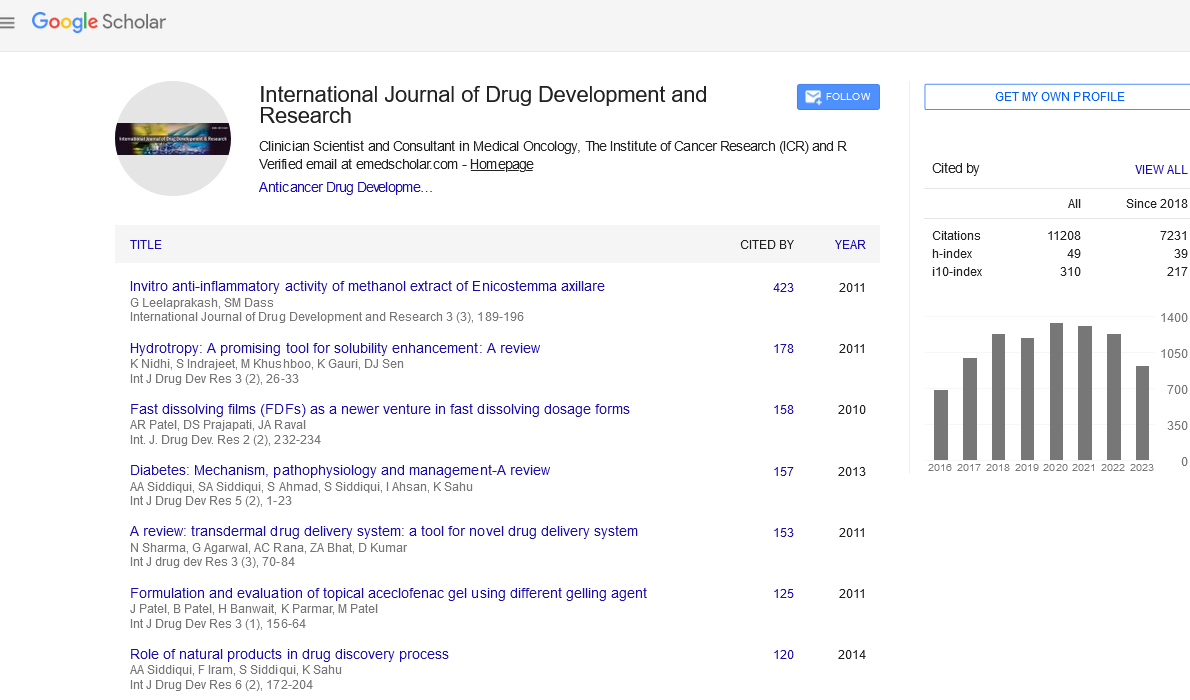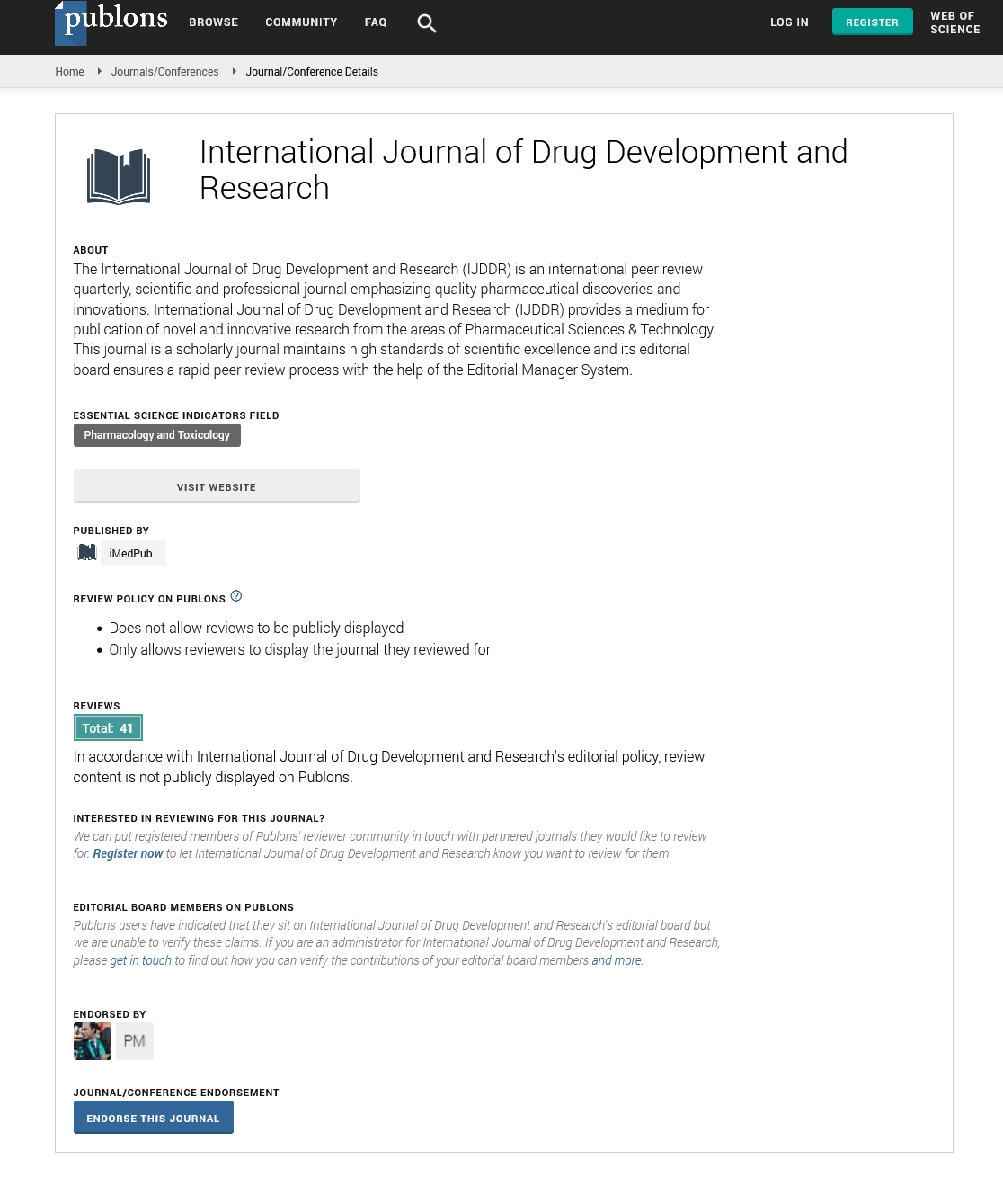Ashwini S1, Shine P Varkey2 and Manjula Shantaram1*
1Department of Studies in Biochemistry, Post Graduate Centre, Mangalore University, Manglore, Karnataka, India
2St. Aloysius Institute of Management and Information Technology, St. Aloysius College (Autonomous), Manglore, Karnataka, India
*Corresponding Author:
Manjula Shantaram
Department of Studies in Biochemistry, Post Graduate Centre, Mangalore University, Manglore, Karnataka, India
Tel: +919845225882
E-mail: manjula59@gmail.com
Received date: July 11, 2017; Accepted date: September 04, 2017; Published date: Setember 06, 2017
Citation: Ashwini S, Varkey SP, Shantaram M (2017) In Silico Docking of Polyphenolic Compounds against Caspase 3-HeLa Cell Line Protein. Int J Drug Dev & Res 9: 28-32
Keywords:
In silico docking; Camptothecin; Quercetin; Epigallocatechin; Coumarin; Gallic acid; Autodocking
Introduction
Cancer is one of the serious threats to humans, causing deaths worldwide in spite of substantial advances in research for its diagnosis and treatment. Almost 20 million new cases are predicted by the year 2020. Disturbingly, the proportion of new cases from the developing countries like India is expected to rise around 70%. The gauge of the problem of cancer in the Indian sub-continent is distressing [1]. Cervical cancer is the commonest cause of death among women in developing countries [2]. According to information center on HPV (human papilloma virus) and cancer in India, every year, 122,844 women are diagnosed with cervical cancer and mortality incidence from this disease is 67,477. In country like India with women population of 432.2 million aged between 15 years and older, are at risk of developing cancer, as it is the second most common cancer found in women aged 15-44 years [3]. Hence, there is a need for search of novel therapeutic drug with minimum side effects against human cervical cancer cell line which is also cost effective. Thus, researchers have turned towards natural products for synthesis of green drug for which, there is a need of knowledge on their interaction with target protein.
Various natural polyphenols have been studied to show cytotoxic effects on human cervical cancer cell lines, thus showcasing new perspectives in drug development against cervical cancer. The five natural compounds considered in this study are the polyphenols. These are a group of chemical substances from natural and herbal extracts which have gained great attention because of their negligible side effects and effective role in anticancer activity. Several studies were carried out to demonstrate the ability of these substances to target viral oncogenes and to inhibit the deregulation and signaling of gene expression of the host cells [4].
The quercetin belongs to the class of flavonoids as inclined to show anti-proliferation, induction of apoptosis against HeLa cell line in vitro and also induction of G2/M phase cell cycle arrest and mitochondrial apoptosis [5]. In vitro studies on HeLa cell line has proved that epigallocatechin, belonging to class of flavan-3-ols showed antiproliferation and induced-apoptosis also inhibited telomerase activity [6]. Gallic acid, belonging to the class of phenolic acids studied in vitro on HeLa cell line was proved to induce of apoptosis [7]. Camptothecin, a natural alkaloid was studied as an anticancer drug to have antiproliferative effect on HeLa cancer cells in low concentrations, through its nature of induction of apoptosis [8]. Coumarin, a naturally occurring substance found in many plants and also their derivatives have tended to induce apoptosis in HeLa cell lines by engaging both extrinsic and intrinsic pathway [9].
The objective of the current study is to analyse the domain and active sites of the caspase 3-hela cell line protein, to perform docking of the polyphenolic compounds and determine their active sites and compound docking so that their potentiality as a therapeutic agent against caspase 3 is assessed.
Materials and Methods
Tools used
Bioinformatics tools: Soft wares like ChemSketch was used for chemical drawing and graphics, Hex 8.0.0; is an Interactive Molecular Graphics Program that calculates and displays possible docking modes of pairs of protein and DNA molecules. Hex can also analyze Protein- Ligand Docking, the ligand is assumed to be rigid, and it superposes several pairs of molecules based only on the knowledge of their 3D shapes [10]. The Spherical Polar Fourier (SPF) correlations were used to enhance the calculations and its one of the few docking programs has built in graphics for interpretation of the result [11].
Protein preparation
The three dimensional structure of HeLa cell line protein Caspase-3 was found as a complex with V266F (Figures 1-6). This was retrieved from the PDB (Protein Data Bank) (https://www.rscb.org/pdb). The complexes bound to the receptor molecule, such as non-essential water molecules, including heteroatoms were removed from the target receptor molecule. Finally, hydrogen atoms were added to the target receptor molecule. The PDB was established in the year 1971, which is the worldwide archive of structural data of biological macromolecules, established by Brookhaven National Laboratories [12].

Figure 1: 2D structure of Quercetin.

Figure 2: 2D structure of Camptothecin.

Figure 3: 2D structure of Epigallocatechin.

Figure 4: 2D structure of Coumarin.

Figure 5: 2D structure of Gallic acid.

Figure 6: Caspase 3 V266 F retrieved from PDB.
Ligand preparation
Five compounds namely Camptothecin, Quercetin, Epigallocatechin, Coumarin and Gallic acid were used for docking studies (Figures 1-5). The structure of these compounds were obtained from the Pubmed literature which shows inhibitory effects towards human cervical cancer cell line proteins [13]. The source for three dimensional structures was from PDB and further used for docking studies.
Docking of receptor with ligands
Caspase 3 receptor was docked with different ligands using Hex 8.0.0 docking software [14,15]. Hex docking was carried out by setting appropriate parameters such as twist range-360, receptor range-180, FFT mode-3D fast lite, ligand range-180, grid dimension-0.6 and distance range-40. The binding energy produced by docking action was tabulated.
Results and Discussion
Bioinformatics is emerging as an important tool in the field of pharmaceutical and drug development with the prospective to significantly improvise the drugs and to check as to how they are originated, carried to the clinical trials and eventually released to the marketplace. This study was performed using HeLa cell line protein caspase-3 and five different compounds, the receptor was derived from Protein Data Bank (PDB) and was used as target for stimulating docking against the five different compounds. These results provide a strong consideration about interactions between the five compounds; camptothecin, quercetin, epigallocatechin, coumarin, gallic acid and caspase 3 which is the human cervical cancer cell line protein. By using Hex 8.0.0 software docking studies were performed and thus their binding model was explored. Further, it is well known that the recognition of binding site between the ligand and the receptor is the beginning point for drug discovery and also to determine the function of protein. In the present study, the active site of HeLa cell line protein caspase 3 was predicted with higher precision figure.
Also the active site of Caspase-3 is comprised of amino acid residues as follows:
ARG64,SER120,HIS121,GLY122,GLN161,ALA162,CYS163,SER2 05,TRP206,ARG207,ASN208,SER209,TRP214,MET222,GLN225,TYR 226,ARG238,ARG241,LYS242,THR245,GLU246,PHE247,GLU248,SE R249,PHE250,SER251,PHE256.
Ligand/Receptor Interaction Studies
The objective of this ligand-protein docking was to explore their predominant binding model of five different ligands with three dimensional structure of a HeLa cell line protein-caspase 3. The intermolecular flexible docking simulation was performed to explore the binding site of the five compounds-camptothecin, quercetin, epigallocatechin, coumarin, gallic acid with HeLa cell line protein Caspase 3. Energy values were calculated from the information obtained while docking the conformations of caspase 3 inhibitor complexes. The crucial interaction information concerning the binding pockets and their orientation of inhibitors in the target protein was obtained. The binding affinity was measured in terms of KJ/mol.
The results of docking and crucial interaction between the ligand and the receptor are shown in figures. The highest negative energy value obtained after docking among five compounds was found between Coumarin with caspase 3 (Figure 7) with value -378.3, followed by camptothecin with caspase 3 (Figure 8), epigallocatechin with caspase 3 (Figure 8) and quercetin with caspase 3 (Figure 9) with docking scores -285.3, -258.2 and -236 respectively. While the least docking score was in docking of Gallic acid with caspase3 (Figures 10 and 11) and the scoring was -181.3 using Hex 8.0.0 docking software (Tables 1 and 2). This prediction on the activities of new inhibitors based on the docking scores gives accurate understanding for ligand and receptor binding interaction, which can be employed for newer drugs against cancer. Higher the negative Etotal value stronger is the interaction between ligand and receptor which leads to activation of receptors.

Figures 7: a, b and c) Docking of Quercetin with caspase 3 receptor.

Figures 8: a, b and c) Docking of Epigallocatechin with caspase 3 receptor.

Figures 9: a, b and c) Docking of Camptothecin with caspase 3 receptor.

Figures 10: a, b and c) Docking of Gallic acid with caspase 3 receptor.

Figures 11: a, b and c) Docking of Coumarin with caspase 3 receptor.
| S. No |
Name of the compound |
Molecular weight |
Log P3 |
H-Bond Donor |
H-Bond Acceptor |
Complexity |
| 1 |
Quercetin |
302.238 g/mol |
1.5 |
5 |
7 |
488 |
| 2 |
Camptothecin |
348.358 g/mol |
1 |
1 |
5 |
742 |
| 3 |
Epigallocatechin |
306.27 g/mol |
0 |
6 |
7 |
380 |
| 4 |
Coumarin |
146.145 g/mol |
1.4 |
0 |
2 |
196 |
| 5 |
Gallic Acid |
170.12 g/mol |
0.7 |
4 |
5 |
169 |
Table 1: Compound details from pubchem.
| S. No |
Ligand |
Hela cell line protein |
Eforce (binding energy of ligand) |
Docking score ETotal Value KJ/mol |
Eshape (energy content of the protein) |
| 1 |
Quercetin |
Caspase-3 |
0 |
-236.0 |
-236.0 |
| 2 |
Epigallocatechin |
Caspase-3 |
0 |
-258.2 |
-258.2 |
| 3 |
Camptothecin |
Caspase-3 |
0 |
-285.3 |
-285.3 |
| 4 |
Coumarin |
Caspase-3 |
0 |
-378.3 |
-378.3 |
| 5 |
Gallic acid |
Caspase-3 |
0 |
-181.3 |
-181.3 |
Table 2: Docking results of caspase 3 receptor with five compounds.
Conclusion
The molecular docking in the current study was concrete enough to discover the binding mechanism and interaction between the five different compounds which are the ligands and the HeLa cell line protein Caspase 3. The results obtained in this study shall be useful for future drug designing and development of novel compounds with higher inhibitory activity against several types of cancer. However, it is necessary to validate these compounds in wet lab studies for establishing them as potential novel candidates.
Acknowledgements
Authors would like to thank St. Aloysius College (Autonomous), Kotekar Post, Madoor, Beeri, Mangalore-575 022, Karnataka for the technical support and Mangalore University for their encouragement.
20409
References
- Ferlay J, Soerjomataram I, Ervik M, Forman D, Bray F, et al. (2012) Globocan 2012, Cancer Incidence and Mortality Worldwide. International Agency for Research on Cancer, France.
- Denny L (2012) Cervical cancer: prevention and treatment. Discov Med 14: 125-131.
- ICO Information Centre on HPV and Cancer (2014) Human Papillomavirus and Related Diseases in India.
- Sun SY, Hail N, Lotan R (2004) Apoptosis as a novel target for cancer chemoprevention. J Natl Cancer Inst 96: 662-672.
- Priyadarsini RV, Murugan RS, Maitreyi S, Ramalingam K, Karunagaran D, et al. (2010) The flavonoid quercetin induces cell cycle arrest and mitochondria-mediated apoptosis in human cervical cancer HeLa cells through p53 induction and NF-B inhibition. Eur J Pharmacol 649: 84-91.
- Yokoyama M, Noguchi M, Nakao Y, Ysunaga M, Yamasaki F, et al. (2008) Antiproliferative effects of the major tea polyphenol, (−)-epigallocatechin gallate and retinoic acid in cervical adenocarcinoma. Gynecologic Oncology 108: 326-331.
- You BR, Moon HJ, Han YH, Park WH (2010) Gallic acid inhibits the growth of HeLa cervical cancer cells via apoptosis and/or necrosis. Food Chem Toxicol 48: 1334-1340.
- Zare-Mirakabadi A, Sarzaeem A, Moradhaseli S, Sayad A, Negahdary M (2012) Necrotic Effect versus Apoptotic Nature of Camptothecin in Human Cervical Cancer Cells. Iran J Cancer Prev 5: 109-116.
- Bronikowska J, Szliszka E, Jaworska D, Czuba ZP, Krol W (2012) The Coumarin Psoralidin Enhances Anticancer Effect of Tumor Necrosis Factor-Related Apoptosis-Inducing Ligand (TRAIL). Molecules 17: 6449-6464.
- Ritchie DW (2003) Evaluation of protein docking predictions using Hex 3.1 in CAPRI rounds 1 and 2. Proteins: Structure, Function, and Bioinformatics. Wiley-liss Inc. 52: 98-106.
- Ritchie DW, Kemp GJL (2000) Protein Docking Using Spherical Polar Fourier Correlations. PROTEINS: Struct. Funct. Genet 39: 178-194.
- The Protein Data Bank (2000) Nucleic Acids Research. Oxfords University Press, p: 28.
- PubMed: Online Search Engine for Science and Biomedical Articles. Available at: www.pubmedcentral.nih.gov
- Vennila S, Bupesh G, Saravanamurali K, Senthil Kumar V, Senthil Raja R, et al. (2014) Bioinformation 10: 263-266.

















